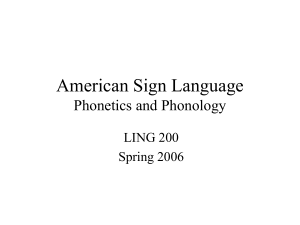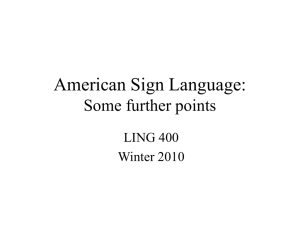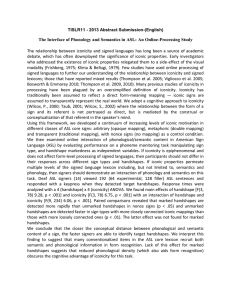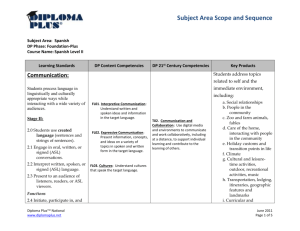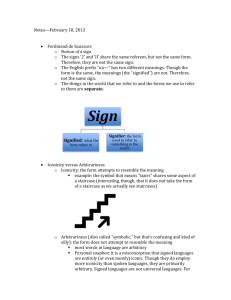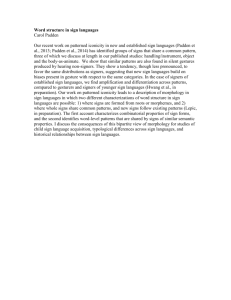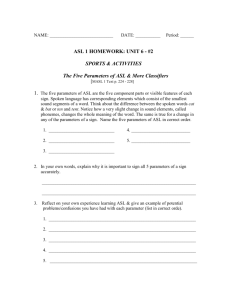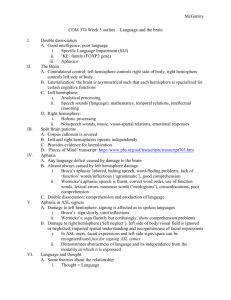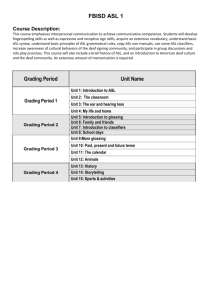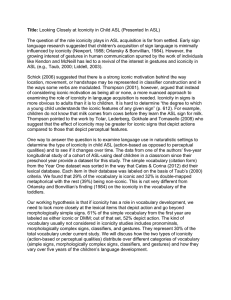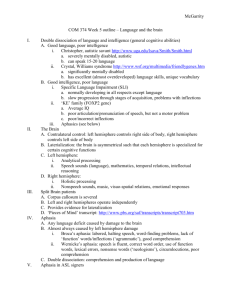Sign language
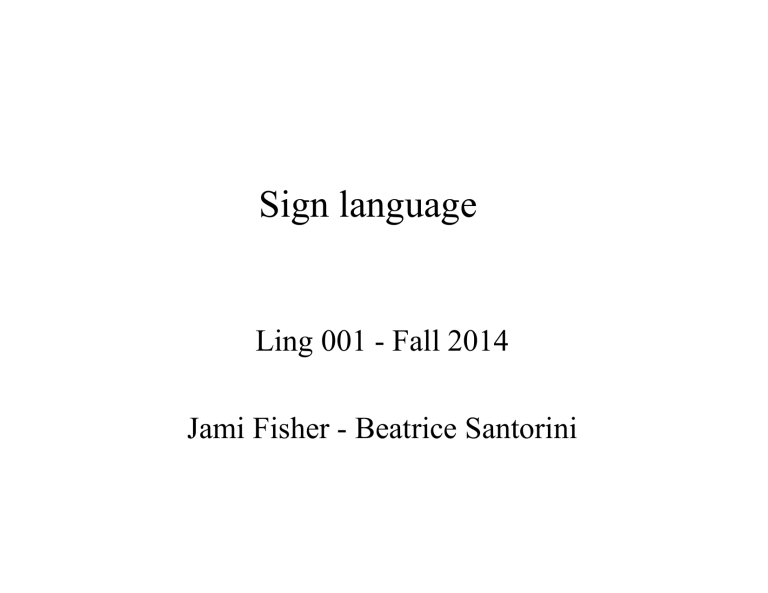
Sign language
Ling 001 - Fall 2014
Jami Fisher - Beatrice Santorini
Sign languages
Visual-spatial languages used by communities of Deaf people
Ethnologue lists 130 Deaf sign languages throughout the world
No universal sign language!
How do sign languages arise?
Spontaneous emergence
• Home sign
• Village sign
Some examples
• Nicaraguan Sign Language
• Al-Sayyid Bedouin Sign Language
• Martha ʼ s Vineyard Sign Language
Comparable to the emergence of pidgins and creoles
3
Iconicity and arbitrariness, 1
All human languages consist of
• Symbols (= form-meaning pairs)
• Rules for possible forms (= phonology)
• Rules for combining symbols into larger meaningful units (= morphology, syntax)
4
Iconicity and arbitrariness, 2
In spoken languages, the form of symbols is mostly arbitrary (onomatopoeia is marginal).
In sign languages, iconicity plays a bigger role.
But even here, iconicity has its limits.
• It underdetermines the form of signs.
• Over time, it is lost.
5
TREE - Chinese Sign Language
TREE - Danish Sign Language
TREE - American Sign Language
Limits of iconicity - Synchronic
All three signs invoke the physical shape of the tree (= iconic).
But the shape is invoked in different ways
(= arbitrary), and the sign is fixed for each language (= conventional).
The signer cannot decide to use a different sign – no matter how iconic.
In other words, conventionality (and to some extent, arbitrariness) trump iconicity.
Limits of iconicity - Diachronic
Iconicity is lost over time.
• HOME was a compound of EAT + BED.
• In the current citation form, the handshape of BED has assimilated to that of EAT.
• Current vernacular forms exhibit further articulatory reduction, making them even less iconic.
• Comparable processes are found in spoken language.
• cup + board cupboard (cubberd)
• some + thing somethin ʼ sumpm
Sign language and the brain, 1
Brain studies provide incontrovertible evidence that sign languages are not pantomime.
Visual and spatial functions are processed by the right hemisphere of the brain.
But sign languages are processed by the left hemisphere, just like spoken languages.
Sign language and the brain, 2 fMRI study (Sakai et al. 2005:1411) shows activation in the left hemisphere for hearing and
Deaf subjects
Sign language and the brain, 3
Damage to right hemisphere results in visual-spatial deficits.
• Inability to create or even copy recognizable drawings
• Failure to notice objects in the left part of the visual field (hemispatial neglect)
But production and understanding of sign language is unaffected.
Sign language and the brain, 4
Damage to the front part of left hemisphere results in Broca ʼ s aphasia.
Production is labored, broken, and simplified.
But comprehension remains intact.
No general motor control deficit (e.g., no difficulty drawing an elephant)
Sign language and the brain, 5
Deaf Broca ʼ s aphasics produce partial errors resulting in nonsense words.
Correct location and movement for FINE, but wrong handshape
Sign language and the brain, 6
Damage to back part of left hemisphere results in
Wernicke ʼ s aphasia.
Fluent but nonsensical production
Comprehension difficulties
Same symptoms for hearing and Deaf
American Sign Language, 1
Not English expressed in signs!
Used in U.S. and anglophone Canada
Historically unrelated to British Sign
Language, and completely distinct (no shared history)
American Sign Language, 2
Historically related to French Sign
Language (used in France, francophone
Canada, and much of continental Europe)
Brought to the U.S. in the 1800s by a
French teacher of the Deaf
Influenced by Martha ʼ s Vineyard Sign
Language and possibly other village sign systems
Also reflects contact with English
(diglossia) 18
Linguistic levels
Signed languages exhibit the same patterning and level of complexity as other languages of the world.
Phonology
Morphology
Syntax
Sociolinguistics
Phonology - Components of signs
Handshape
Location
Movement
Palm orientation
Non-manual features
Unmarked handshapes, 1
21
Unmarked handshapes, 2
Perceptually most distinct and salient
Universal across sign languages
Used most frequently in each sign language
Acquired earliest
Phonologically less restricted
22
Marked handshapes
20+ in ASL
Articulatorily and perceptually more complex
Less common in and across sign languages
Acquired later
Phonologically more restricted
Handshape - Crosslinguistic variation
Each sign language uses a limited number of possible handshapes.
Handshapes may be grammatical in one sign language, but ungrammatical in another.
Taiwan Sign Language signs for BROTHER and
SISTER are ungrammatical handshapes in ASL.
24
Handshape - Contrasts
Minimal pairs show that handshape is part of a morpheme ʼ s lexical entry
(i.e., it must be memorized).
Contrastive role in CANDY / APPLE
Location
Place of articulation relative to face, torso, or non-dominant hand or arm
Again, minimal pairs show that location is part of a morpheme ʼ s lexical entry
Contrastive role in SUMMER / UGLY /
DRY
Movement
Primary movements
• Straight vs. arc vs. hook ( “ 7 ” )
• Vertical vs. horizontal
• Towards vs. away from the body
• Unidirectional vs. bidirectional
Secondary movements
• Wiggling or hooking fingers
Contrastive role in CHAIR / TRAIN
Orientation
Different parts of the hand can be oriented differently
Palm
up or down
in or out
ipsilateral (facing right for right hand, or left for left) or contralateral (facing left for right hand, or right for left)
Fingertips
Cf. U vs. H
Contrastive role in SOCK / STAR
Non-manuals, 1
Non-manual gestures involve the head, eyebrows, mouth, position of body, etc.
Independent of expression of affect !
Contrastive role in LATE / NOT-YET
Non-manuals, 2
Adverbial modification
• Headshake ʻ negation ʼ
• MM ʻ as usual, with enjoyment ʼ
• TH ʻ carelessly, sloppily ʼ
Discourse function markers
• Marked vs. unmarked clauses
• Question (vs. statement)
30
Morphology, 1
Like all spoken languages, ASL has two types of morphology.
Inflectional (results in different form of same word)
sing + -s sing-s
Derivational (results in new word)
sing + er sing-er
Like many spoken languages, ASL exhibits nonlinear morphology.
Even English has some nonlinear morphology.
Linear (suffix): play + past play + -ed play -ed
Nonlinear (ablaut): sing + past s-ng + -a- s -ang
Morphology, 2
Movement is productive in the formation of deverbal nouns.
• SIT / CHAIR
• IRON, v. / IRON, n.
Location can express natural gender.
• female: chin (e.g., MOTHER)
• male: forehead (e.g., FATHER)
Morphology, 3
An important source of new words is compounding (= combining two independent signs).
“ Blending ” and “ smoothing ” over time lead to loss of iconicity.
Recall HOME (< EAT + BED)
• Cf. smog < smoke + fog
• Blending is unusual in spoken languages, but the norm in signed languages.
33
Morphology, 4
ASL has no case, grammatical gender, or true tense (cf. Chinese).
It has a minimal person distinction.
But it has an extremely expressive system of verbal aspect (cf. pidgins and creoles).
Aspect is expressed nonlinearly.
• Sign with circular movement = continuous
(over and over on a single occasion)
• Sign repeated = iterative (over and over on more than one occasion)
34
Syntax – Basic clause structure
Three word orders are common in
ASL.
Before non-manuals were recognized, word order was considered to be free.
Today, SVO is considered the basic order.
Syntax – Marked clause structures
Clause-initial non-subjects ( “ topics ” ) must be marked by raised eyebrows and head tilt.
• SVO S , _VO
• SVO O , SV_ (but *OSV)
• SVO VO , S__ (but *VOS)
Spoken language counterparts
• Topic morphemes (like Japanese – wa )
• Intonation (as in English)
Syntax - Phrase structure change
Early ASL (like most of the world ʼ s spoken languages) seems to have been SOV.
The change from SOV to SVO seems to have taken place in the 1900s.
Most likely causes
• Oralism in the early 1900s
• Continuing diglossia with English
37
Sociolinguistics
Spoken languages vary according to social parameters such as formality, region, ethnicity, social class, and gender.
The same is true of ASL.
Regional variation, 1
Regional variation, 2
Each sign represents a mask, but in different ways.
Ethnic variation
Schools for the Deaf were segregated in the
South into the 1970s.
41
Gender variation, 1
Men are more likely to use newer signs, and women more likely to retain older ones.
Gender variation, 2
References
Sakai, Kuniyoshi, Yoshinori Tatsuno, Kei Suzuki, Harumi
Kimura, and Yasuhiro Ichida. 2005. Sign and speech: amodal commonality in left hemisphere dominance for comprehension of sentences. Brain 128:1407-1417.
"
Morphology, 5
Discourse entities are assigned a location in space
Different classes of verbs use the locations in different ways
Orientation: HATE = back of hand toward subject, palm toward object
Location: HELP = first location of subject, then location of object
Syntax - Constraints on movement
As in English, topicalization in ASL is constrained by universal principles.
Simple structure
I like apples.
Apples, I like __ .
Coordinate structure
I like apples and bananas.
* Bananas, I like apples and __.

